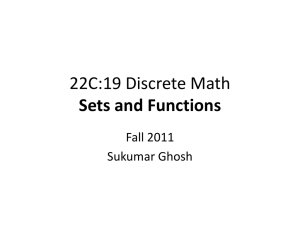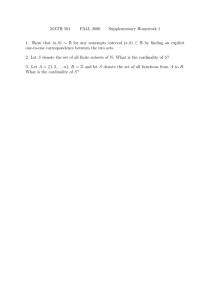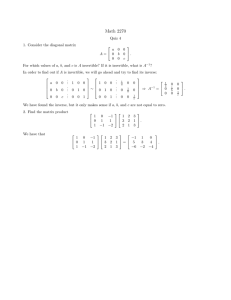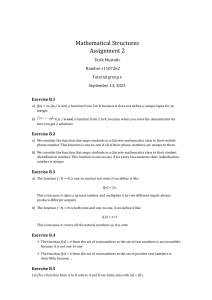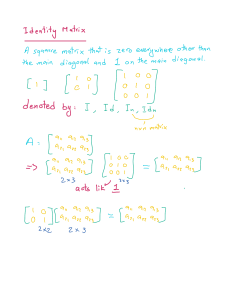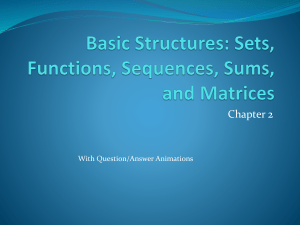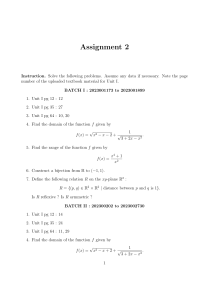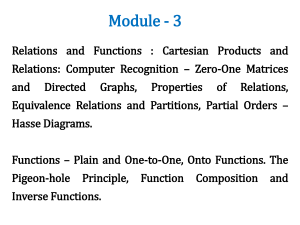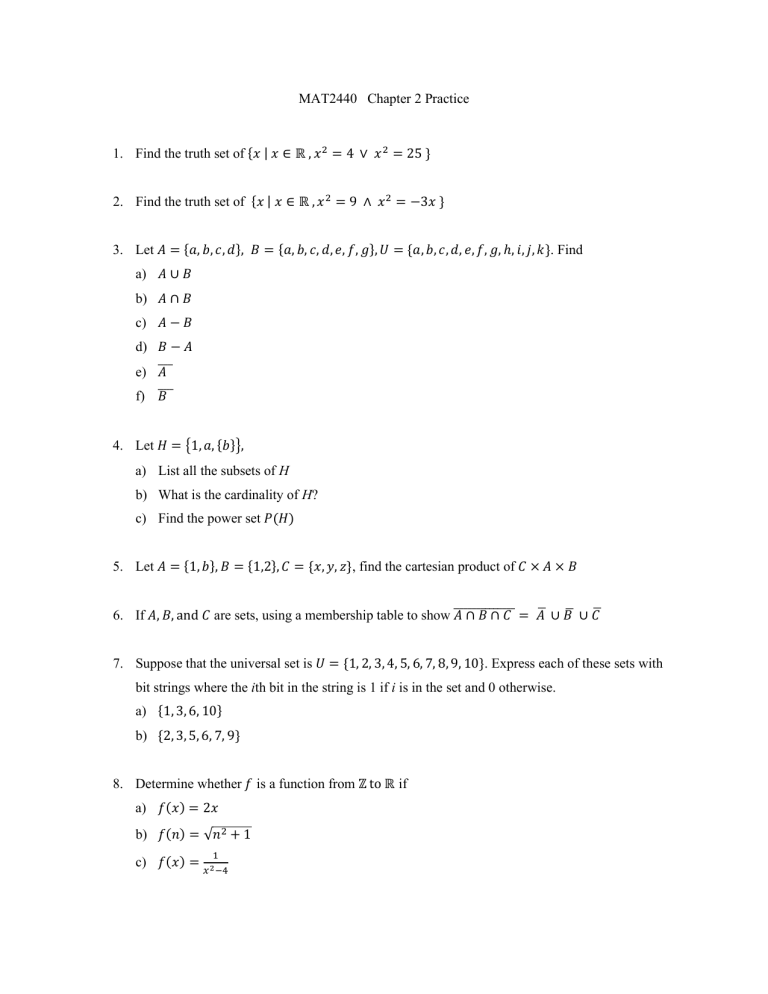
MAT2440 Chapter 2 Practice
1. Find the truth set of {𝑥𝑥 | 𝑥𝑥 ∈ ℝ , 𝑥𝑥 2 = 4 ∨ 𝑥𝑥 2 = 25 }
2. Find the truth set of {𝑥𝑥 | 𝑥𝑥 ∈ ℝ , 𝑥𝑥 2 = 9 ∧ 𝑥𝑥 2 = −3𝑥𝑥 }
3. Let 𝐴𝐴 = {𝑎𝑎, 𝑏𝑏, 𝑐𝑐, 𝑑𝑑}, 𝐵𝐵 = {𝑎𝑎, 𝑏𝑏, 𝑐𝑐, 𝑑𝑑, 𝑒𝑒, 𝑓𝑓, 𝑔𝑔}, 𝑈𝑈 = {𝑎𝑎, 𝑏𝑏, 𝑐𝑐, 𝑑𝑑, 𝑒𝑒, 𝑓𝑓, 𝑔𝑔, ℎ, 𝑖𝑖, 𝑗𝑗, 𝑘𝑘}. Find
a) 𝐴𝐴 ∪ 𝐵𝐵
b) 𝐴𝐴 ∩ 𝐵𝐵
c) 𝐴𝐴 − 𝐵𝐵
d) 𝐵𝐵 − 𝐴𝐴
e) ���
𝐴𝐴
f) �𝐵𝐵���
4. Let 𝐻𝐻 = �1, 𝑎𝑎, {𝑏𝑏}�,
a) List all the subsets of H
b) What is the cardinality of H?
c) Find the power set 𝑃𝑃(𝐻𝐻)
5. Let 𝐴𝐴 = {1, 𝑏𝑏}, 𝐵𝐵 = {1,2}, 𝐶𝐶 = {𝑥𝑥, 𝑦𝑦, 𝑧𝑧}, find the cartesian product of 𝐶𝐶 × 𝐴𝐴 × 𝐵𝐵
��������������
6. If 𝐴𝐴, 𝐵𝐵, and 𝐶𝐶 are sets, using a membership table to show 𝐴𝐴
∩ 𝐵𝐵 ∩ 𝐶𝐶 = 𝐴𝐴� ∪ 𝐵𝐵� ∪ 𝐶𝐶�
7. Suppose that the universal set is 𝑈𝑈 = {1, 2, 3, 4, 5, 6, 7, 8, 9, 10}. Express each of these sets with
bit strings where the ith bit in the string is 1 if i is in the set and 0 otherwise.
a) {1, 3, 6, 10}
b) {2, 3, 5, 6, 7, 9}
8. Determine whether 𝑓𝑓 is a function from ℤ to ℝ if
a) 𝑓𝑓(𝑥𝑥) = 2𝑥𝑥
b) 𝑓𝑓(𝑛𝑛) = √𝑛𝑛2 + 1
c) 𝑓𝑓(𝑥𝑥) =
1
𝑥𝑥 2 −4
9. Find the following values.
a) ⌈ −2.4 ⌉
b) ⌊ −2.4 ⌋
c) ⌈ 0.6 + ⌊ 2.7 ⌋ ⌉
10. Determine whether each of these functions from ℤ to ℤ is one-to-one.
a) 𝑓𝑓(𝑛𝑛) = 3𝑛𝑛 + 3
b) 𝑓𝑓(𝑛𝑛) = 𝑛𝑛2 + 1
c) 𝑓𝑓(𝑛𝑛) = 𝑛𝑛3
d) 𝑓𝑓(𝑛𝑛) = 𝑛𝑛3 + 2𝑛𝑛2
11. Determine whether 𝑓𝑓: ℤ × ℤ → ℤ is onto if
a) 𝑓𝑓(𝑚𝑚, 𝑛𝑛) = 2𝑚𝑚 − 𝑛𝑛
b) 𝑓𝑓(𝑚𝑚, 𝑛𝑛) = 𝑚𝑚2 − 𝑛𝑛2
12. Determine whether each of these functions is a bijection from ℝ to ℝ.
a) 𝑓𝑓(𝑥𝑥) = 3𝑥𝑥 + 4
b) 𝑓𝑓(𝑥𝑥) = −3𝑥𝑥 2 + 4
c) 𝑓𝑓(𝑥𝑥) =
𝑥𝑥
𝑥𝑥+5
d) 𝑓𝑓(𝑥𝑥) = 𝑥𝑥 3
e) 𝑓𝑓(𝑥𝑥) = 𝑥𝑥 3 − 5𝑥𝑥 2
13. Find 𝑓𝑓 ∘ 𝑔𝑔 and 𝑔𝑔 ∘ 𝑓𝑓 where 𝑓𝑓(𝑥𝑥) = 𝑥𝑥 2 + 1 and 𝑔𝑔(𝑥𝑥) = 2𝑥𝑥 + 5 are functions from ℝ to ℝ.
14. Is function 𝑓𝑓(𝑥𝑥) = 2𝑥𝑥 + 5 invertible from ℝ to ℝ? If so, what is inverse function? And compute
𝑓𝑓 −1 (1).
15. What are the terms 𝑎𝑎0 , 𝑎𝑎1 , 𝑎𝑎2 , and 𝑎𝑎3 of the sequence {𝑎𝑎𝑛𝑛 }, where 𝑎𝑎𝑛𝑛 equals
a) (−2)2
b) 3
c) 7 + 3𝑛𝑛
d) 2𝑛𝑛 + (−2)𝑛𝑛
𝑛𝑛
𝑛𝑛
e) � � + � �
2
2
16. Find the next five terms of the sequence defined by each of these recurrence relations and given
initial conditions.
a) 𝑎𝑎𝑛𝑛 = −2𝑎𝑎𝑛𝑛−1 , 𝑎𝑎0 = 1
b) 𝑎𝑎𝑛𝑛 = 𝑎𝑎𝑛𝑛−1 − 𝑎𝑎𝑛𝑛−2 , 𝑎𝑎0 = 2, 𝑎𝑎1 = −1
2
c) 𝑎𝑎𝑛𝑛 = 3𝑎𝑎𝑛𝑛−1
, 𝑎𝑎0 = 1
2
d) 𝑎𝑎𝑛𝑛 = 𝑛𝑛𝑎𝑎𝑛𝑛−1 + 𝑎𝑎𝑛𝑛−2
, 𝑎𝑎0 = −1, 𝑎𝑎1 = 0
e) 𝑎𝑎𝑛𝑛 = 𝑎𝑎𝑛𝑛−1 − 𝑎𝑎𝑛𝑛−2 + 𝑎𝑎𝑛𝑛−3 , 𝑎𝑎0 = 1, 𝑎𝑎1 = 1, 𝑎𝑎2 = 2
17. For each of these lists of integers, provide a simple formula or rule that generates the terms of an
integer sequence that begins with the given list. Assuming that your formula or rule is correct,
determine the next three terms of the sequence.
a) 2, −2, 2, −2, 2, …
b) 3, 6, 9, 12, 15, 18, …
c) 10, 8, 6, 4, 2, …
d) 2, 8, 32, 128, 512, …
e) 1,
1 1 1
1
, ,
,
,…
3 9 27 81
18. What are the values of the following questions?
a) 𝑆𝑆 = {1, 3, 5, 7}, ∑𝑗𝑗∈𝑆𝑆 𝑗𝑗 2 + 1
b) ∑5𝑘𝑘=1(2𝑘𝑘 − 1)
c) ∑10
𝑖𝑖=1 2
d) ∑6𝑘𝑘=0�2𝑘𝑘+1 − 2𝑘𝑘 �
e) ∏8𝑖𝑖=5(𝑖𝑖 − 1)
f) ∑2𝑖𝑖=1 ∑3𝑗𝑗=1(2𝑖𝑖 + 3𝑗𝑗)
g) ∑2𝑖𝑖=0 ∑3𝑗𝑗=0(𝑖𝑖 2 𝑗𝑗)
